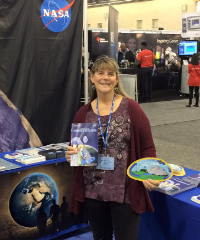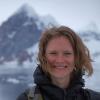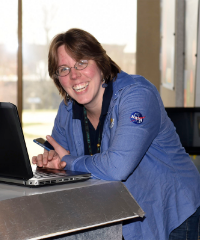Community Blogs
Community Blogs
Discover how the GLOBE community is engaging in all things GLOBE through the community blog posts below.
Learn how to create a GLOBE community blog post.
Filter By:
Blogs List
The third and fourth grade students whom I work with at Cedar Grove ES asked me what will happen once the El Nino conditions begin to subside, and I admitted that I really wasn't sure. So, we used the internet and looked it up! We found a website that answered our question! Discovery News has a great article with videos and graphics at http://news.discovery.com/earth/weather-extreme-events/will-la-nina-follow-one-of-the-strongest-ever-el-ninos-160410.htm .
This article suggests that this strong El Nino season may be followed by a La Nina event. Like all good ...
Read More »
Posted in:
Dorian Janney, GLOBE Scientist Mentor Blog for El Nino Field Campaign
I have had the pleasure of working with two groups of elementary school students this year as their GLOBE mentor. They attend Cedar Grove Elementary School in Clarksburg, MD. My primary goal was to install an instrument box with a rain gauge and a multi-day thermometer at their school, and to help them collect and report data to GLOBE. Here they are collecting data:
As we observed the weather patterns, they began to ask what the difference was between weather and climate. I gave ...
Posted in:
Water Availability can be defined as "The hydrologic capacity of a water source (surface water body, groundwater, municipal water) to sustain additional water demands after considering other current water uses and water conditions. (GEMI, 2012)
The Soil Moisture Active Passive Mission provides information on water availability and environmental stress for estimating plant productivity and potential yield. The availability of direct observations of soil moisture status and the timing and extent of potential frost damage from SMAP enables significant improvements in operational crop ...
Posted in:
Field Campaigns:
SMAP
Primary Audience:
TRAINERS
STUDENTS
TEACHERS
PARTNERS
SCIENTISTS
ALUMNI
COUNTRY COORDINATORS
Penguins have the right of way at land and sea! The first thing I noticed when we landed at Peterman Island (off the west coast of the Antarctic Peninsula) was long sled tracks down the hillside.
As I walked to take a closer look, I had to wait for a fearless gentoo penguin to cross the path in front of me, since penguins have the right of way!
Winter childhood memories of sledding with my brothers in Ohio, USA flooded my heart when I then saw several penguins tobogganing, sliding down ...
Posted in:
In the midst of a very up and down El Niño season, have you ever wondered: are all El Niños the same? For the answer to that question, we need to compare data imagery from two separate El Niño events. And what better way to do that then with global observations from space. One place to find what we’re looking for is the Center for Climate Sciences, El Niño page.
http://climatesciences.jpl.nasa.gov/enso
Here scientists compare multiple datasets from the largest El Niño on record, 1997-1998, with the current 2015-2016 El Niño season. Some of the datasets show what are called ...
Posted in:
What do students in Lima Peru and Ida Michigan have in common? The answer is quite simple, the dramatic effects of this year’s El Niño. Thanks in part to The GLOBE Program’s worldwide reach in connecting schools with one another; mentorship from Dr. Kevin Czajkowski from the University of Toledo and the inquisitive nature of students from Ida Middle School.
Students from Mrs. Lanna Harmon’s 6 th grade class of Ida Middle School in Ida Michigan reached out to work with students from ESD Coordinator Mrs. Milagros Gallegos’s 7 th grade ESD Club from Colegio Altair School in Lima, Peru. ...
Posted in:
Our zodiac landed on a flat volcanic beach to an unexpected sight. Gentoo penguins and Antarctic fur seals were everywhere!
The abandoned buildings proved we were not the first people these animals shared a beach with. Dozens of seals and penguins seemed unaware of the law, the Antarctic Treaty, to keep a minimum of 5 meters from humans.
I was first introduced to the International Antarctic Treaty when I asked my ...
Posted in:
Not all raindrops are created equal. The size of falling raindrops depends on several factors, including where the cloud producing the drops is located on the globe and where the drops originate in the cloud. For the first time, scientists have three-dimensional snapshots of raindrops and snowflakes around the world from space, thanks to the joint NASA and Japan Aerospace Exploration Agency Global Precipitation Measurement (GPM) mission. With the new global data on raindrop and snowflake sizes this mission provides, scientists can improve rainfall estimates from satellite data and in ...
Posted in:
Volcanoes, a steamy lagoon, abandoned buildings, abundant wildlife: my first sight of Antarctica. This is a deception of my prediction of Antarctica, which is quite fitting for the name of our first landing: Deception Island.
The first documented people, sealers in the 1800’s, were deceived as they sailed through the entrance point, Neptune’s Bellow. They thought they’d reach open sea, but were instead encased in this horseshoe-shaped island.
The very first Antarctic fur seal sighting will stick in my mind ...
Posted in:
Tomorrow I will bridge to the LA Zoo at least by using their handouts with data capture on our campus.
I am setting up by research teams by tables by teacher classroom. They love their recorders and soon will add taking the room temperature into their own research area collected by investigative team/table 1-5. They will be exploring predictions, measurements, fractions, parts, wholes and sums or averages, maps, map making and breathing like the lungs of the planet while we learn words like canopy, bionome, humus, serpentine to describe maps and reading symbols, signs, and ...
Posted in:
The freezing and thawing of our planet's soil can make a big impact on our climate. Check out the blog below to see just how important this is.
SMAP’s focus also includes measurements of freeze/thaw, which tells us whether the land surface is frozen or thawed in areas north of 45-degree north latitude. This is very important to know, because when the vegetation is frozen there is minimal exchange of gasses (CO2 primarily) between the vegetation and the atmosphere. It’s as if the vegetation were in a state of hibernation. This changes however, when spring begins and temperature rises ...
Posted in:
Field Campaigns:
SMAP
Primary Audience:
TRAINERS
TEACHERS
STUDENTS
PARTNERS
SCIENTISTS
ALUMNI
COUNTRY COORDINATORS
Greetings from Ushuaia, Argentina South America - the southernmost city on our amazing planet! Hello, I’m Laura Schetter a GLOBE teacher, from Holland, Ohio, USA. This city is the site we will embark on the Ocean Endeavor ship to reach Antarctica. From the west coast of the Antarctic Peninsula, I will be collecting hydrosphere and atmospheric data for GLOBE. Additionally, I will enter “water stories” - accounts of interactions with water for the H2you Project (h2youproject.com).
This International Antarctic Expedition is with Robert Swan and his 2041 ...
Posted in:
We are just about one month into the El Niño Field Campaign and we have many schools that have gone above and beyond expectations.
Teacher, Jeff Bouwman, at Shumate Middle School in Michigan, has taken his student science to the next level. By maximizing his classroom space to using the great outdoors to do great science, #GettingScienceDone is setting the bar high for student GLOBE measurements.
Students from the Medford Memorial Middle School in New Jersey, and teacher, Vicky Gorman, have been collecting samples well before the campaign began. From getting their hands dirty in ...
Posted in:
We are pleased to welcome guest blogger Jacob Spivey. Jacob is a senior undergraduate in Meteorology with a minor in Climatology at Penn State University. Fascinated by weather extremes as he was growing up, today he looks at possible relationships between extreme weather and climate change. Within the past few years, he has also begun looking at how these subjects are communicated to the general public, a process which he has started doing himself in his online blog, Weatherbolt .
Ask someone what they think of when they hear about climate change, and you might get a ...
Posted in:
"The Atlanta Science Festival is an annual public celebration of local science and technology. From March 19-26, 2016, curious people of all ages will explore the science and technology in our region and see how science is connected to all parts of our lives in 100 engaging events, including hands-on activities, facility tours, presentations, and performances throughout the metro Atlanta region." --- http://atlantasciencefestival.org/
On Saturday, March 19, there was a GLOBE/SMAP Training Workshops at the Captain Planet Foundation. Participants learned how to take soil ...
Posted in:
Field Campaigns:
SMAP
Primary Audience:
TRAINERS
TEACHERS
STUDENTS
PARTNERS
SCIENTISTS
ALUMNI
COUNTRY COORDINATORS
Want to hear about this in their own words? Watch the recording of Webinar #3
Posted in:
Dramatic images show El Niño beginning to rescue California from its drought!
As you may know, the state of California has been facing drought conditions for some time now. Over the last few months, the El Niño phenomenon has brought much needed precipitation to the drought-stricken state.
Click HERE to read the full story and see the evidential images.
Posted in:
The SMAP Mission satellite launched on 31-January 2015 from the Vandenberg Air Force Base in California. Check out the video below to watch it take off!
Posted in:
Field Campaigns:
SMAP
Primary Audience:
TRAINERS
TEACHERS
STUDENTS
PARTNERS
SCIENTISTS
ALUMNI
COUNTRY COORDINATORS
Check out how CNES and NASA scientists are using GLOBE protocols to study El Niño
During the Fall 2015 American Geophysical Union (AGU) conference, scientist from Centre National D’Etudes Spatial (CNES) and National Aeronautics and Space Administration (NASA) came together to present findings on how CNES and NASA are using GLOBE protocols to study El Niño.
GLOBE partner and CNES scientist Danielle DeStaerke and NASA scientist Margaret Srinivasan used the Atmosphere/Climate, Hydrology, Land Cover/Biology and Phenology protocols to study impacts of El Niño.
Finding more about ...
Posted in:
How do SMAP Scientists Use GLOBE Data (Part II)?
Data Analysis and Blog by Dr. Erika Podest, SMAP Scientist
In order to start using GLOBE soil moisture data we need at least 15 measurements collected on days when SMAP flew overhead. The Varazdin School is an example of such and the chart below is a comparison between their data and SMAP soil moisture at 36 km 2 spatial resolution.
Figure 2: Comparison between SMAP and GLOBE soil moisture from Varazdin school in Croatia.
There are several things to note in Fig. 2. First, GLOBE measurements collected early on did not ...
Posted in:
Field Campaigns:
SMAP
Primary Audience:
TRAINERS
TEACHERS
STUDENTS
PARTNERS
SCIENTISTS
ALUMNI
COUNTRY COORDINATORS
—
20 Items per Page












